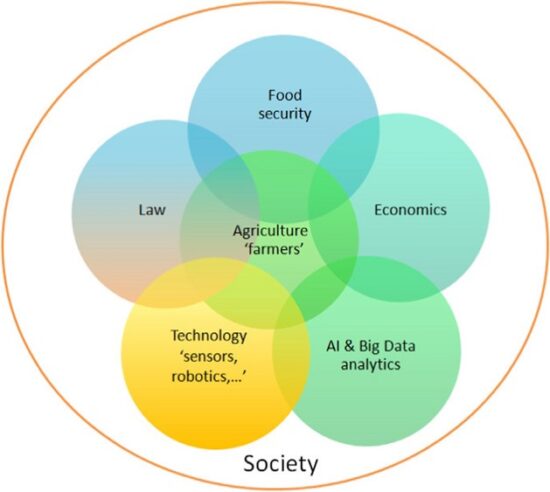
Can artificial intelligence (AI) help us to understand plants better and as a result improve the quality of food we grow as well as yields? The answer is yes. But we need to fill in the missing data to let AI do the job. What’s needed are large datasets that include plant genotyping, phenotyping, weather, soil, subsurface moisture, precipitation and insect and other pest infestation histories. Using AI can then begin to give farmers the means to make data-driven decisions to optimize crop quality and yields. If you are not familiar with the first two terms, genotyping is the genetic makeup of plants while phenotyping describes plant physiology.
Today, farms use field robots and drones to survey and image crops, differentiate between the healthy and the sick, and determine where to apply fertilizer and water. Equipped with sensors and imaging technology tied to machine learning algorithms, these non-human players have become essential tools for modern agronomy.
Today’s farms use computers as the locus of operations. The computers receive real-time data from the field sent by smart machines. At the same time, the computers are connected to the Internet to amass information to help with forecasting that isn’t just about the weather but also about other agribusiness issues.
Using AI to study plants is the next stage in the computerization of farming. AI may help us overcome our present realities, a finite world facing a growing human population and the existential threat of climate change to our food supply.
AI is the subject of a paper published on May 30, 2024, in a special issue of the Journal Agronomy entitled: “AI, Sensors, and Robotics for Smart Agriculture.” Its authors are Baohua Zhang of the College of Artificial Intelligence at Nanjing Agricultural University in China, and Yongliang Qiao, at the Australian Centre for Field Robotics, University of Sydney in Australia. They describe the current state of traditional agricultural practices in the face of an unsustainable future. They point to the need to implement smart farming practices to improve crop quality, yields and neighbouring ecology. To achieve this they state that farms need to use sensors, robotics, the Internet of Things (IoT), data management technology and intelligent decision-making algorithms. The last is AI.
AI isn’t new to plant science. Nor are robots and drones that roam fields or hover over them where they take photographs to determine plant health and sense field conditions. Using these smart machines lets agricultural scientists analyze plant traits and come up with new genetic combinations that can resist drought, disease and insect pests.
Among the newest of these AI tools is one from Google DeepMind called AlphaFold. It is helping scientists understand the vast number and function of proteins. Why are proteins so important to study? Proteins are critical to cell function. DNA makes RNA which in turn creates proteins from chemicals within the plant cell. Proteins are made up of amino acid chains that cells use to do self-repair. They fuel metabolism and regulate biochemistry. Their varying structures impact genetics at the molecular scale. Understanding their function in plants helps to reveal how they respond to drought, poor soil conditions, and pathogens. We can see genotype modifications in plants in reaction to repeated stresses all started through proteins.
Another factor to consider is epigenetics. Epigenetics is the study of factors beyond DNA that affect cells. These factors can influence what proteins get produced within a cell. Epigenetic changes occur from a variety of causes including external ones like drought, and disease. Without changing the sequence of genetic information epigenetic factors can switch off specific genes influencing the epigenome that can determine plant growth and maturation.
Now you know why proteins are important in the study of plants. In the most recent research on plant biology, a paper in PLOS Computational Biology notes that before AlphaFold, less than 2% of proteins were known in one particular model plant species called Arabidopsis thaliana, a member of the mustard family. Up until AlfphaFold, we knew 10 times more about proteins in humans than those in plants. With AlphaFold, however, we have discovered more than 60% of Arabidopsis’ proteins.
Going back to the need for datasets, the only way AI can help farmers is if we accumulate much more data for machine and deep learning to munch on. A recent comment from those in the field of agronomy bears repeating. There is a lack of agronomists who both understand biology and computer science. A recent review of agricultural science notes that the fine-tuning of agricultural tasks lacks large datasets. Most of the datasets being used today to train machine and deep learning AIs are non-agriculture specific.
With digital agriculture still in its infancy compared to other scientific disciplines, the dearth of these datasets makes it harder to produce enhanced value from AI. The largest of existing agricultural-oriented datasets come from Landsat and other Earth-observation satellites. What is missing are large datasets accumulated from much lower down including farms, agronomists and scientists who in their daily work are producing significant amounts of useful information for machine and deep learning algorithms to mine. This needs to be a global imperative in response to human population growth, the need to protect the environments in which we grow food, and the existential threat of anthropogenic climate change.








